实例介绍
【实例截图】
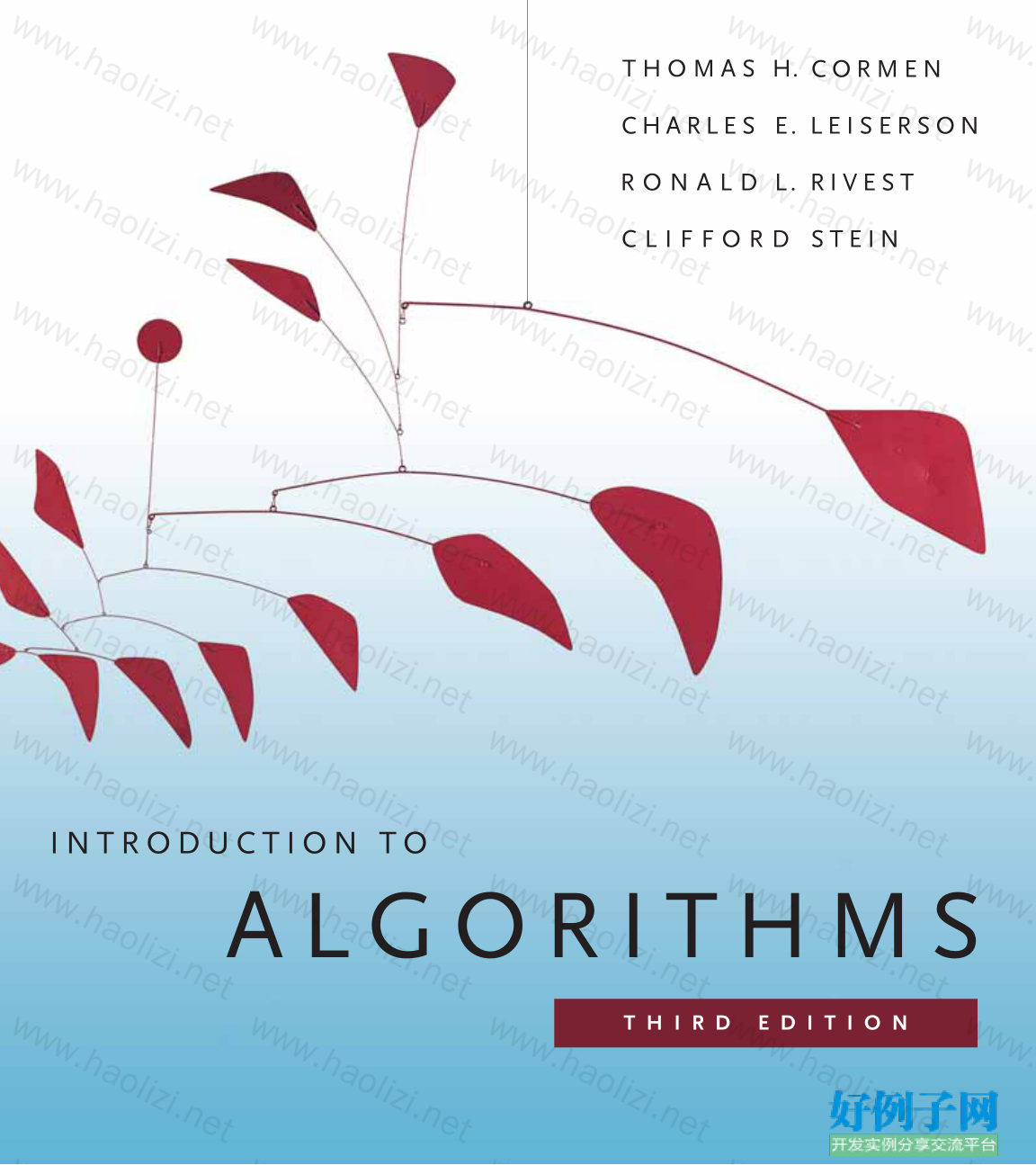

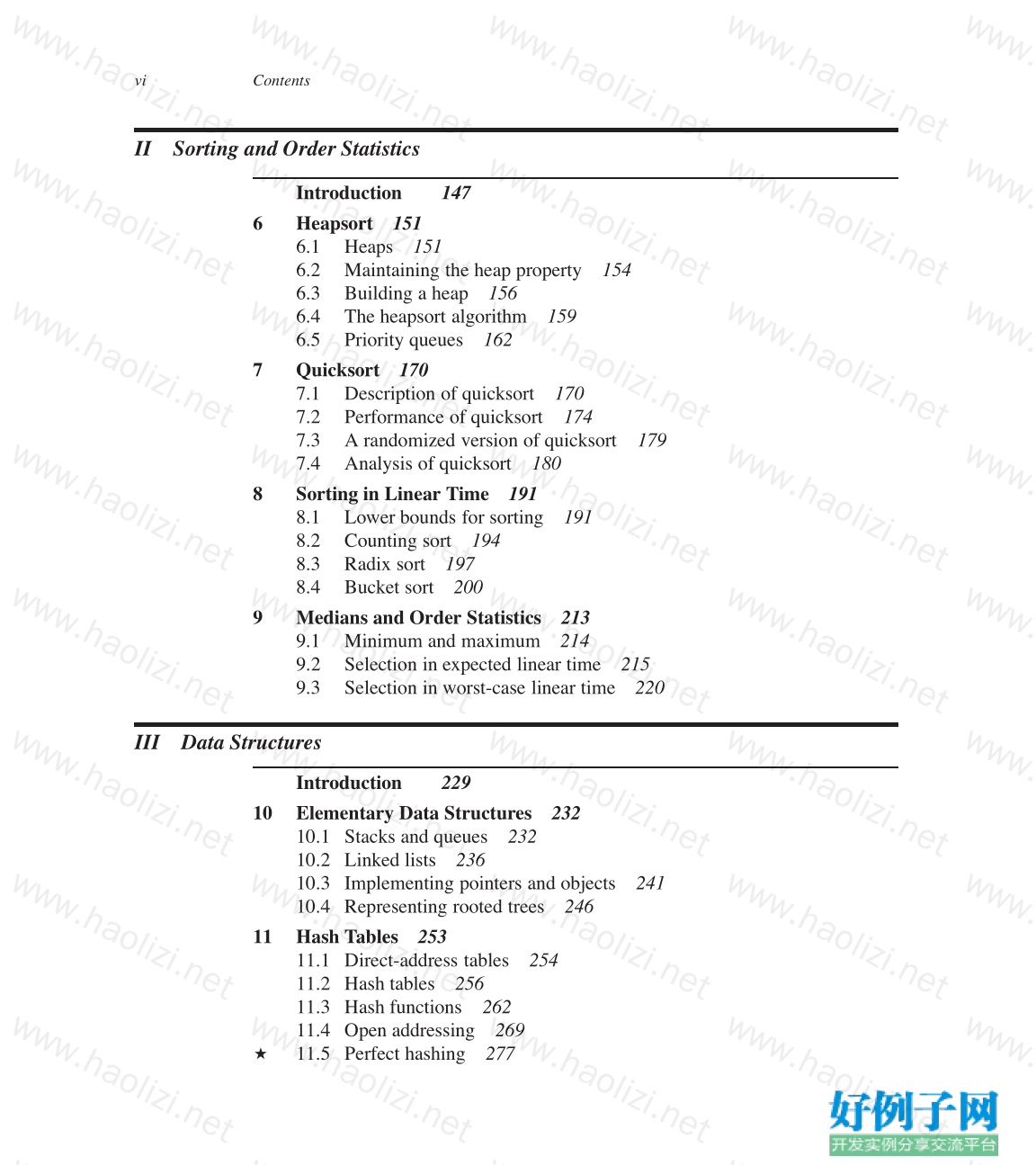

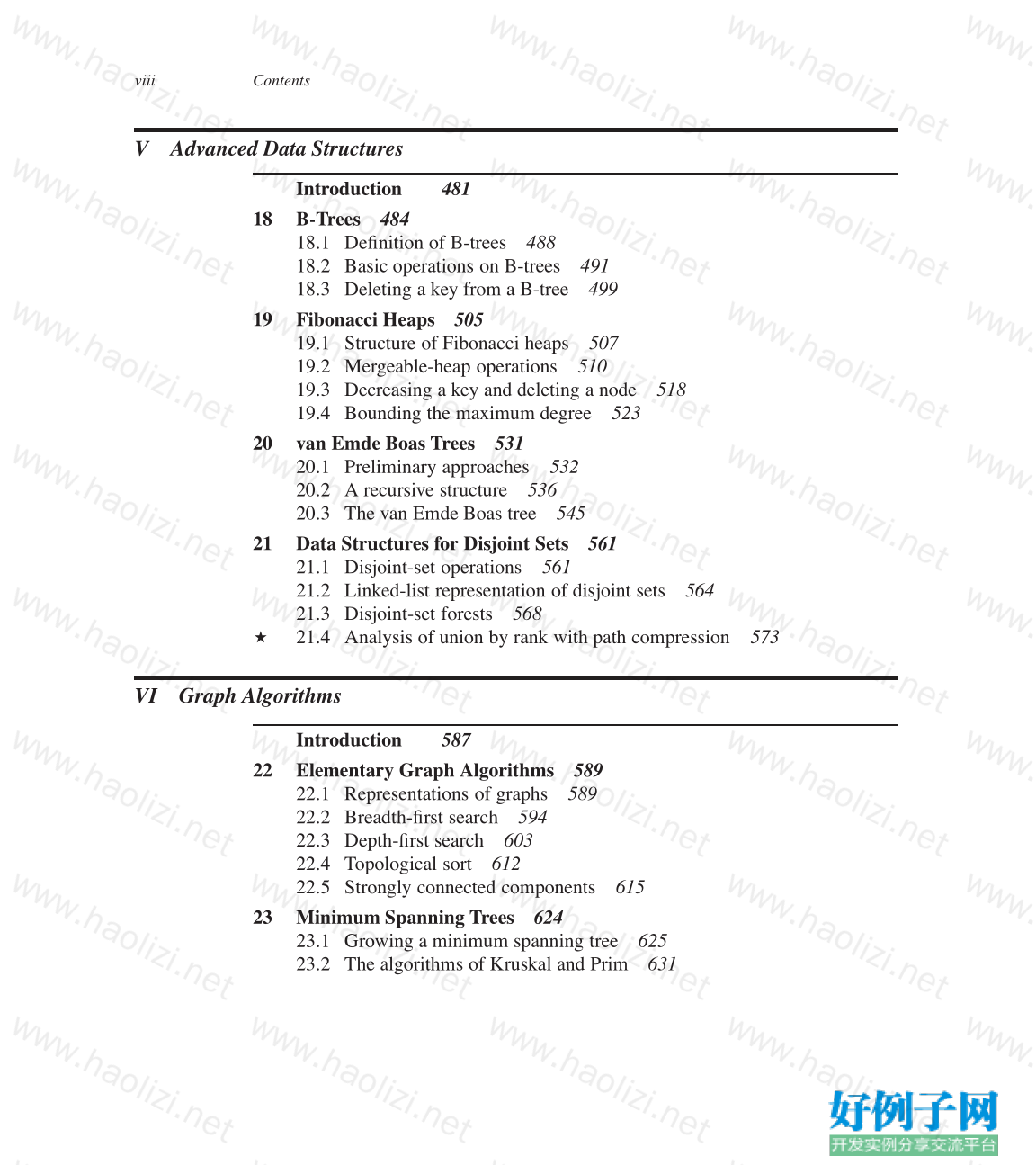

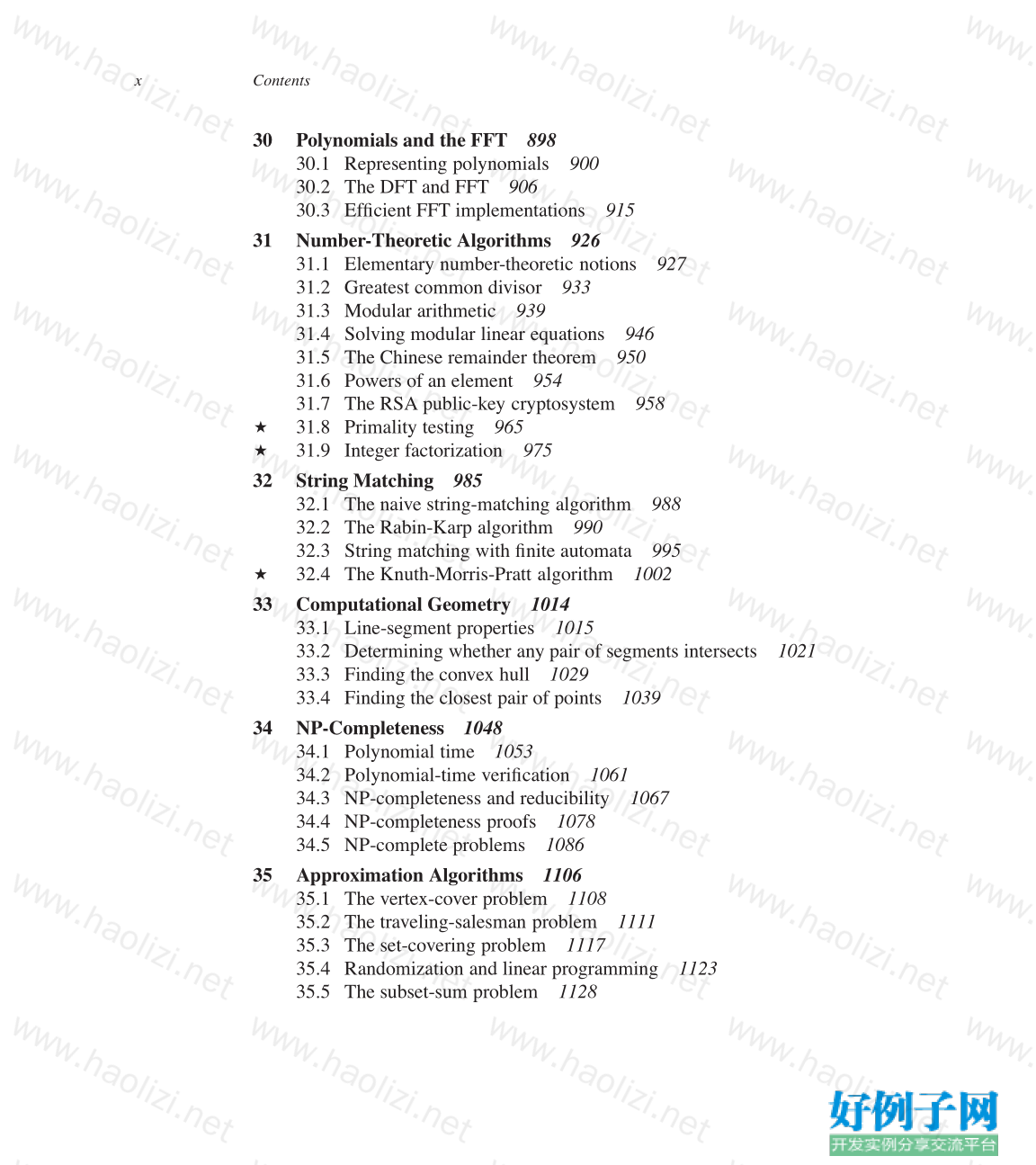
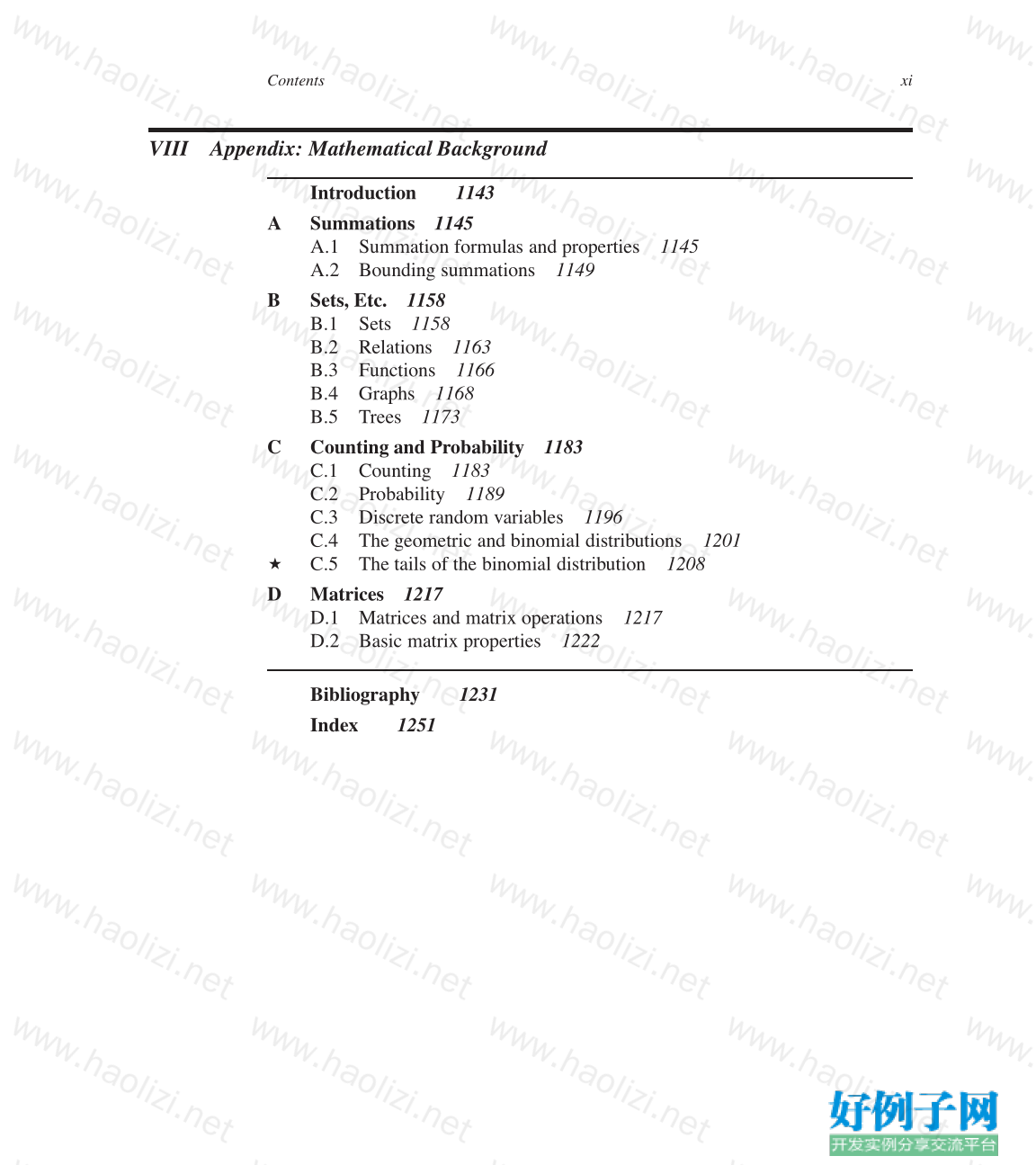
【核心代码】
Contents
Preface xiii
I Foundations
Introduction 3
1 The Role of Algorithms in Computing 5
1.1 Algorithms 5
1.2 Algorithms as a technology 11
2 Getting Started 16
2.1 Insertion sort 16
2.2 Analyzing algorithms 23
2.3 Designing algorithms 29
3 Growth of Functions 43
3.1 Asymptotic notation 43
3.2 Standard notations and common functions 53
4 Divide-and-Conquer 65
4.1 The maximum-subarray problem 68
4.2 Strassen’s algorithm for matrix multiplication 75
4.3 The substitution method for solving recurrences 83
4.4 The recursion-tree method for solving recurrences 88
4.5 The master method for solving recurrences 93
? 4.6 Proof of the master theorem 97
5 Probabilistic Analysis and Randomized Algorithms 114
5.1 The hiring problem 114
5.2 Indicator random variables 118
5.3 Randomized algorithms 122
? 5.4 Probabilistic analysis and further uses of indicator random variables
130
vi Contents
II Sorting and Order Statistics
Introduction 147
6 Heapsort 151
6.1 Heaps 151
6.2 Maintaining the heap property 154
6.3 Building a heap 156
6.4 The heapsort algorithm 159
6.5 Priority queues 162
7 Quicksort 170
7.1 Description of quicksort 170
7.2 Performance of quicksort 174
7.3 A randomized version of quicksort 179
7.4 Analysis of quicksort 180
8 Sorting in Linear Time 191
8.1 Lower bounds for sorting 191
8.2 Counting sort 194
8.3 Radix sort 197
8.4 Bucket sort 200
9 Medians and Order Statistics 213
9.1 Minimum and maximum 214
9.2 Selection in expected linear time 215
9.3 Selection in worst-case linear time 220
III Data Structures
Introduction 229
10 Elementary Data Structures 232
10.1 Stacks and queues 232
10.2 Linked lists 236
10.3 Implementing pointers and objects 241
10.4 Representing rooted trees 246
11 Hash Tables 253
11.1 Direct-address tables 254
11.2 Hash tables 256
11.3 Hash functions 262
11.4 Open addressing 269
? 11.5 Perfect hashing 277
Contents vii
12 Binary Search Trees 286
12.1 What is a binary search tree? 286
12.2 Querying a binary search tree 289
12.3 Insertion and deletion 294
? 12.4 Randomly built binary search trees 299
13 Red-Black Trees 308
13.1 Properties of red-black trees 308
13.2 Rotations 312
13.3 Insertion 315
13.4 Deletion 323
14 Augmenting Data Structures 339
14.1 Dynamic order statistics 339
14.2 How to augment a data structure 345
14.3 Interval trees 348
IV Advanced Design and Analysis Techniques
Introduction 357
15 Dynamic Programming 359
15.1 Rod cutting 360
15.2 Matrix-chain multiplication 370
15.3 Elements of dynamic programming 378
15.4 Longest common subsequence 390
15.5 Optimal binary search trees 397
16 Greedy Algorithms 414
16.1 An activity-selection problem 415
16.2 Elements of the greedy strategy 423
16.3 Huffman codes 428
? 16.4 Matroids and greedy methods 437
? 16.5 A task-scheduling problem as a matroid 443
17 Amortized Analysis 451
17.1 Aggregate analysis 452
17.2 The accounting method 456
17.3 The potential method 459
17.4 Dynamic tables 463
viii Contents
V Advanced Data Structures
Introduction 481
18 B-Trees 484
18.1 Definition of B-trees 488
18.2 Basic operations on B-trees 491
18.3 Deleting a key from a B-tree 499
19 Fibonacci Heaps 505
19.1 Structure of Fibonacci heaps 507
19.2 Mergeable-heap operations 510
19.3 Decreasing a key and deleting a node 518
19.4 Bounding the maximum degree 523
20 van Emde Boas Trees 531
20.1 Preliminary approaches 532
20.2 A recursive structure 536
20.3 The van Emde Boas tree 545
21 Data Structures for Disjoint Sets 561
21.1 Disjoint-set operations 561
21.2 Linked-list representation of disjoint sets 564
21.3 Disjoint-set forests 568
? 21.4 Analysis of union by rank with path compression 573
VI Graph Algorithms
Introduction 587
22 Elementary Graph Algorithms 589
22.1 Representations of graphs 589
22.2 Breadth-first search 594
22.3 Depth-first search 603
22.4 Topological sort 612
22.5 Strongly connected components 615
23 Minimum Spanning Trees 624
23.1 Growing a minimum spanning tree 625
23.2 The algorithms of Kruskal and Prim 631
Contents ix
24 Single-Source Shortest Paths 643
24.1 The Bellman-Ford algorithm 651
24.2 Single-source shortest paths in directed acyclic graphs 655
24.3 Dijkstra’s algorithm 658
24.4 Difference constraints and shortest paths 664
24.5 Proofs of shortest-paths properties 671
25 All-Pairs Shortest Paths 684
25.1 Shortest paths and matrix multiplication 686
25.2 The Floyd-Warshall algorithm 693
25.3 Johnson’s algorithm for sparse graphs 700
26 Maximum Flow 708
26.1 Flow networks 709
26.2 The Ford-Fulkerson method 714
26.3 Maximum bipartite matching 732
? 26.4 Push-relabel algorithms 736
? 26.5 The relabel-to-front algorithm 748
VII Selected Topics
Introduction 769
27 Multithreaded Algorithms 772
27.1 The basics of dynamic multithreading 774
27.2 Multithreaded matrix multiplication 792
27.3 Multithreaded merge sort 797
28 Matrix Operations 813
28.1 Solving systems of linear equations 813
28.2 Inverting matrices 827
28.3 Symmetric positive-definite matrices and least-squares approximation
832
29 Linear Programming 843
29.1 Standard and slack forms 850
29.2 Formulating problems as linear programs 859
29.3 The simplex algorithm 864
29.4 Duality 879
29.5 The initial basic feasible solution 886
x Contents
30 Polynomials and the FFT 898
30.1 Representing polynomials 900
30.2 The DFT and FFT 906
30.3 Efficient FFT implementations 915
31 Number-Theoretic Algorithms 926
31.1 Elementary number-theoretic notions 927
31.2 Greatest common divisor 933
31.3 Modular arithmetic 939
31.4 Solving modular linear equations 946
31.5 The Chinese remainder theorem 950
31.6 Powers of an element 954
31.7 The RSA public-key cryptosystem 958
? 31.8 Primality testing 965
? 31.9 Integer factorization 975
32 String Matching 985
32.1 The naive string-matching algorithm 988
32.2 The Rabin-Karp algorithm 990
32.3 String matching with finite automata 995
? 32.4 The Knuth-Morris-Pratt algorithm 1002
33 Computational Geometry 1014
33.1 Line-segment properties 1015
33.2 Determining whether any pair of segments intersects 1021
33.3 Finding the convex hull 1029
33.4 Finding the closest pair of points 1039
34 NP-Completeness 1048
34.1 Polynomial time 1053
34.2 Polynomial-time verification 1061
34.3 NP-completeness and reducibility 1067
34.4 NP-completeness proofs 1078
34.5 NP-complete problems 1086
35 Approximation Algorithms 1106
35.1 The vertex-cover problem 1108
35.2 The traveling-salesman problem 1111
35.3 The set-covering problem 1117
35.4 Randomization and linear programming 1123
35.5 The subset-sum problem 1128
Contents xi
VIII Appendix: Mathematical Background
Introduction 1143
A Summations 1145
A.1 Summation formulas and properties 1145
A.2 Bounding summations 1149
B Sets, Etc. 1158
B.1 Sets 1158
B.2 Relations 1163
B.3 Functions 1166
B.4 Graphs 1168
B.5 Trees 1173
C Counting and Probability 1183
C.1 Counting 1183
C.2 Probability 1189
C.3 Discrete random variables 1196
C.4 The geometric and binomial distributions 1201
? C.5 The tails of the binomial distribution 1208
D Matrices 1217
D.1 Matrices and matrix operations 1217
D.2 Basic matrix properties 1222
Bibliography 1231
Index 1251
标签:
小贴士
感谢您为本站写下的评论,您的评论对其它用户来说具有重要的参考价值,所以请认真填写。
- 类似“顶”、“沙发”之类没有营养的文字,对勤劳贡献的楼主来说是令人沮丧的反馈信息。
- 相信您也不想看到一排文字/表情墙,所以请不要反馈意义不大的重复字符,也请尽量不要纯表情的回复。
- 提问之前请再仔细看一遍楼主的说明,或许是您遗漏了。
- 请勿到处挖坑绊人、招贴广告。既占空间让人厌烦,又没人会搭理,于人于己都无利。
关于好例子网
本站旨在为广大IT学习爱好者提供一个非营利性互相学习交流分享平台。本站所有资源都可以被免费获取学习研究。本站资源来自网友分享,对搜索内容的合法性不具有预见性、识别性、控制性,仅供学习研究,请务必在下载后24小时内给予删除,不得用于其他任何用途,否则后果自负。基于互联网的特殊性,平台无法对用户传输的作品、信息、内容的权属或合法性、安全性、合规性、真实性、科学性、完整权、有效性等进行实质审查;无论平台是否已进行审查,用户均应自行承担因其传输的作品、信息、内容而可能或已经产生的侵权或权属纠纷等法律责任。本站所有资源不代表本站的观点或立场,基于网友分享,根据中国法律《信息网络传播权保护条例》第二十二与二十三条之规定,若资源存在侵权或相关问题请联系本站客服人员,点此联系我们。关于更多版权及免责申明参见 版权及免责申明



网友评论
我要评论